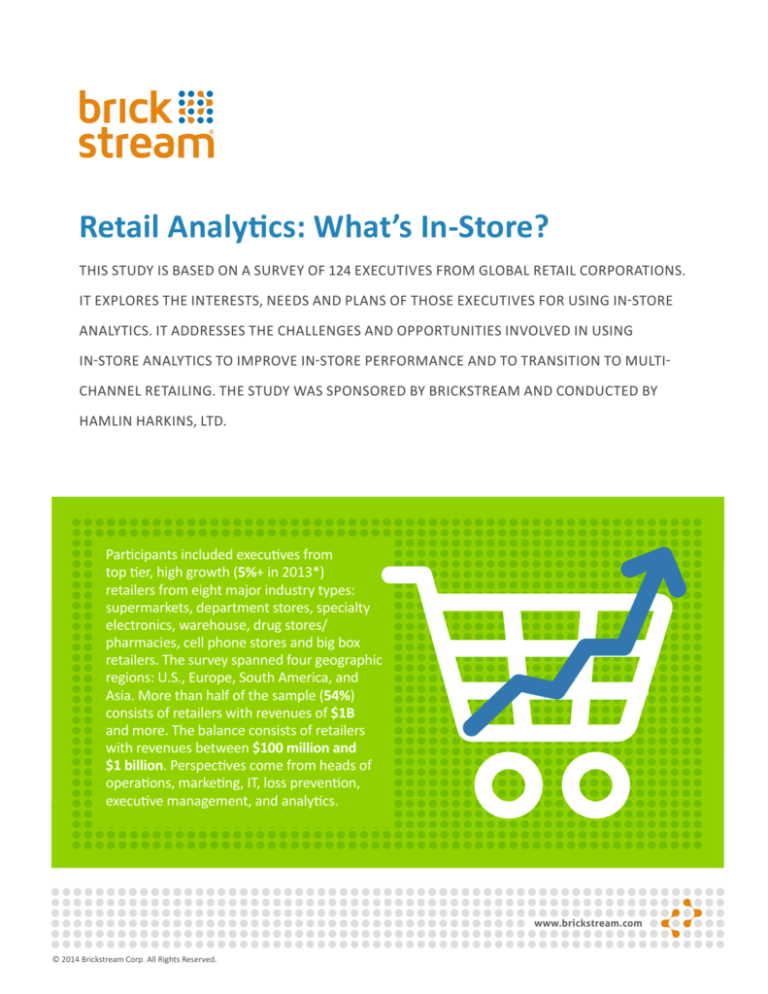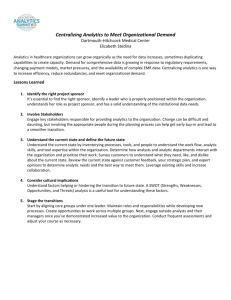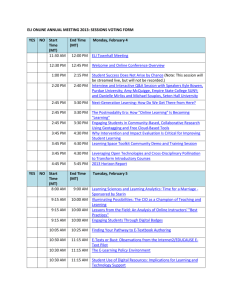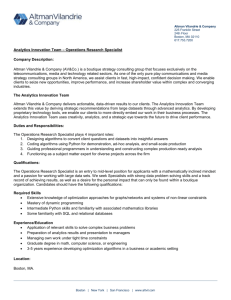
Retail Analytics: What’s In-Store?
THIS STUDY IS BASED ON A SURVEY OF 124 EXECUTIVES FROM GLOBAL RETAIL CORPORATIONS.
IT EXPLORES THE INTERESTS, NEEDS AND PLANS OF THOSE EXECUTIVES FOR USING IN-STORE
ANALYTICS. IT ADDRESSES THE CHALLENGES AND OPPORTUNITIES INVOLVED IN USING
IN-STORE ANALYTICS TO IMPROVE IN-STORE PERFORMANCE AND TO TRANSITION TO MULTICHANNEL RETAILING. THE STUDY WAS SPONSORED BY BRICKSTREAM AND CONDUCTED BY
HAMLIN HARKINS, LTD.
Participants included executives from
top tier, high growth (5%+ in 2013*)
retailers from eight major industry types:
supermarkets, department stores, specialty
electronics, warehouse, drug stores/
pharmacies, cell phone stores and big box
retailers. The survey spanned four geographic
regions: U.S., Europe, South America, and
Asia. More than half of the sample (54%)
consists of retailers with revenues of $1B
and more. The balance consists of retailers
with revenues between $100 million and
$1 billion. Perspectives come from heads of
operations, marketing, IT, loss prevention,
executive management, and analytics.
www.brickstream.com
© 2014 Brickstream Corp. All Rights Reserved.
RETAILER MULTI-CHANNEL READINESS: EARLY EXPLORERS
“Multi-channel retailing” means delivering a seamless retail experience to
consumers across store, e-commerce, mobile, and social channels. The retail
community is optimistic about using in-store analytics to deliver that experience
for brick-and-mortar retail operations.
Executives are aware that they need to make the transition to multi-channel
retailing. Yet, most are still in the early stages of exploring options, learning about
how in-store analytics can help, and considering what applications to try first.
While top-tier retailers are moving into multi-channel activity, overall patterns in
executives’ reactions for the larger retail market indicate four major trends:
➊ They do not feel adequately informed.
➋ They are unclear about which in-store analytics they need and about
realistic expectations for investing in the technology to capture in-store
analytics.
➌ They are learning about in-store analytics within their functional and
departmental silos. This creates confusion and disjointed thinking about
whether they have the analytics they need and about how to best make
use of analytics for the transition.
➍ They welcome advice from credible, neutral resources that can help them
learn about available tools, and a cost-effective, practical approach to
deploying and realizing ROI from in-store analytics.
Retailers in this market require education and support to smooth their path
in becoming early adopters. While many technology vendors present select
information about retail analytics, retailers seek a trustworthy resource that
can educate them about proven methods for improving performance, customer
loyalty, and revenue.
*This criteria was used because RSRs research
shows retailers which are growing faster than
the average are early adopters of technology,
are more aggressive in their plans for moving
to multi-channel and are more motivated
to improve customer experience. Our data
validates this group is adopting multi-channel
practices sooner than other retailers.
www.brickstream.com
2
Retail Analytics: What’s In-Store?
TRANSITION TO MULTI-CHANNEL MARKETING
Multichannel retailing is an emerging concept that many retailers are just
beginning to understand. There is no single owner responsible for multi-channel
retailing. However, the survey shows that most retail professionals look to
marketing leaders for guidance and leadership on this new model. At the same
time, retailers concede that distributed parties including marketing, IT, sales,
executives, finance, merchandising, buyers, and public relations are involved in
multi-channel efforts. These parties all see a need for in-store analytics and
believe it will benefit their work. Interviews indicate these parties work
independently (rather than as a team) to evaluate the overall strategic value
of this to the enterprise.
The timeline for becoming fully multi-channel is typically within one to four years.
IN WHAT TIMEFRAME DO YOU EXPECT YOUR ORGANIZATION
WILL BE FULLY MULTI-CHANNEL?
19%
30%
2016-18
We are now
50%
2014-15
SUPERMARKETS AND DEPARTMENT STORES ARE EARLY ADOPTERS
The store is the dominant transaction channel in retail. And yet, it is the one
channel where retailers lack customer behavior analytics beyond transactions,
mystery shopper data, and surveys. In support of this, retailers are examining how
to collect and use in-store analytics. These retailers anticipate investments one
year to 18 months out (2015-16). Currently, supermarkets and department stores
adopt and invest in in-store analytics and multi-channel activities earlier than other
retailers. Drug stores are slower to adopt. Retailers report using multiple channels
today. Store, e-commerce, and customer loyalty data are the most commonly used.
Social and mobile channels are emerging. Social media and mobile applications are
less frequently used.
www.brickstream.com
3
Retail Analytics: What’s In-Store?
WHAT CHANNELS DOES YOUR OPERATION USE
TODAY, OR HAVE PLANS TO USE IN THE FUTURE?
WHICH OF THE FOLLOWING TECHNOLOGIES DO
YOU PLAN TO USE?
88% Stores
68% Wi-Fi in the store
86% Ecommerce
68% Loyalty system
81% Customer Loyalty
52% Mobile payment or wireless POS
76% Social Media Apps
52% Queue management
74% Mobile Apps
33%
Bluetooth Low Energy
29%
NFC/BLE-enabled signage
4%
Interest is high for using in-store technologies in the future.
Strategies include people counting, Wi-Fi in the store, loyalty
programs, mobile payments, customer product preferences,
queue management and Bluetooth Low Energy (BLE),
and electronic signage to gain a deeper understanding of
customer purchase patterns.
Others*
*Phone apps; inventory mgt.; customer suggestions and follow-up
TECHNOLOGIES COUNT FOR RETAILERS;
RETAILERS PLAN TO USE THE FOLLOWING TECHNOLOGIES BY 2015:
Source: © 2014 Brickstream Global Retailer Survey “Retail Analytics: What’s In-Store?”
www.brickstream.com
4
Retail Analytics: What’s In-Store?
BELIEVE MULTI-CHANNEL RETAILING WILL HELP SALES
ACROSS ALL CHANNELS
Consistently, retailers feel developing a seamless experience for customers across
all channels will have a positive impact on their businesses and will produce
stronger sales revenue in every channel. This belief is a strong motivator for the
difficult changes required to move from multiple non-integrated channels to
seamless channels. When asked to rate the anticipated impact on sales by channel
within their businesses, retailers are positive across all key channels.
MULTI-CHANNEL INCREASES SALES FOR ALL CHANNELS
Anticipated impact on sales by channel
Ecommerce
Store sales
Mobile sales
Social sales
Call centers
Catalog sales
Source: © 2014 Brickstream Global Retailer Survey “Retail Analytics: What’s In-Store?”
Other sales
channels
E-commerce and the store are expected to enjoy the biggest impact. To truly
understand how multi-channel retailing affects each channel, the retailer must
have comparable analytics from each channel. In-store analytics comparable to
e-commerce, mobile commerce, social commerce and call-center commerce are
sorely lacking.
IT’S NOT JUST MARKETING THAT BENEFITS
Retailers consistently identify marketing as the lead function that can benefit from
in-store analytics, although they solidly cite several other functions that can benefit
as well. They mention merchandising, operations and loss prevention as other
areas that will be able to effectively use customer behavior data from the store
for overall business improvements. By and large, there is a clear rallying cry for
marketing to take the lead on coordinating and driving the case for value.
www.brickstream.com
5
Retail Analytics: What’s In-Store?
WHICH GROUPS DO YOU FEEL BENEFIT THE MOST
FROM UNDERSTANDING THE DATA ABOUT WHAT
GOES ON IN THE STORE (“10” IS AVERAGE)?
Group
Mean
Med.
S.D.
Freq.
Marketing
15.7
10.0
10.3
124
Merchandising
14.1
10.0
9.3
124
Operations
13.5
10.0
9.3
124
Loss Prevention
11.7
9.0
9.0
124
Other
10.5
6.0
11.9
6
MEANS BY TYPE OF RETAIL
Group
Super
Big Box
Elect/Cell
Dep’t.
MEANS BY ROLE
Drug/
Other
Operations
Mktg.
IT
Loss Prev/
Other
Marketing
16.2
12.3
17.1
17.2
12.9
14.4
15.9
19.2
14.3
Merchandising
13.9
11.9
15.0
15.7
13.4
12.7
14.1
16.2
14.4
Operations
13.9
12.2
14.4
13.6
12.3
12.0
12.8
17.4*
12.8
Loss Prevention
12.3
12.0
11.9
1.2
9.3
9.8
11.9
14.3*
12.4
There are two significant exceptions in expectations
➊ Asian participants expect merchandising to benefit
their business more than other retailers do.
➋ IT executives expect operations and loss prevention
to benefit the business more than other functions.
ANTICIPATED INVESTMENTS NEED REFINEMENT
Anticipated investments to capture useful in-store analytics
range broadly by industry-type. The average amount spent is
$12.8 million. However, the range by industry is wide: $25.6
million for department stores to $.5 million for drug stores.
The range of estimates and uncertainty in responses signals
the need to support retailers with helpful guidance about
realistic budgeting and expectations. They want to know what
it will cost to get in-store analytics.
RELATIVE TO BUDGETS, HOW MUCH HAS YOUR
ORGANIZATION BUDGETED FOR ANALYTICS?
Type of Retail
Average Budget
Overall
$12,868,000
Electronics/Cell Phone
$25,554,800
Department Store
$25,626,200
Supermarket
$6,458,700
Big Box/Warehouse
$2,819,500
Drug Store/Other
$510,000
www.brickstream.com
6
Retail Analytics: What’s In-Store?
INFORMATION SOUGHT ABOUT IN-STORE ANALYTICS
Retailers see the potential value of securing a robust range
of in-store analytics. Because they are familiar with people
counting, they place a premium on customer traffic data.
They specifically value counts of how many customers enter
the store and how many customers who enter the store
actually buy something, also known as sales conversion.
Next, they most value knowing which promotions attract
customers, where various customers go in the store, and
how many times customers pick up their own brand products
instead of national brands.
The values placed on in-store analytics are predominantly
consistent across industries and regions. Small differences in
this data exist by retailers. Department stores score the value
of promotion effectiveness more highly than other retailers.
Supermarkets score customer dwell time at specific displays
and knowing the number of incidents of sweet-hearting more
highly than other retailers.
IF “0” IS NOT AT ALL VALUABLE AND “10” IS AVERAGE, WHAT SCORE WOULD YOU GIVE FOR HOW
VALUABLE IT WOULD BE FOR YOU TO KNOW….
Topics
Mean
Median
S.D.
Freq.
How many customers enter the store
20.7
20.0
9.8
124
How many customers who enter the store buy something
20.5
20.0
9.9
124
Which promotions attract customers
18.5
20.0
10.4
124
Where the customers go in the store
18.2
20.0
10.8
124
Times customers pick up own brand products instead of national brands
18.0
16.5
10.4
112
Where specific type of customer goes in the store
17.4
16.0
10.5
124
How many times a specific customer enters a specific store
17.0
15.0
10.1
124
Service times
16.4
15.0
10.2
124
Out of stock items
16.4
15.0
10.9
124
Track demographics of private level credit card holders
16.4
14.5
11.2
112
How long customers wait in line
16.3
10.0
10.9
124
Whether customers are checking prices online from smart phones while in a store
(i.e. show-rooming)
15.8
13.0
10.2
124
Wait times in lines
15.8
12.0
10.3
124
Lengths of lines for customers who wait
15.8
15.0
10.1
124
Times customers select and the de-select own brand items
15.8
11.5
10.4
112
How long customers dwell at a specific display
15.6
14.0
10.4
124
Compliance on end cap displays
15.3
12.0
10.6
124
Determine how many incidents of posible sweet-hearting
14.0
10.0
10.7
124
www.brickstream.com
7
Retail Analytics: What’s In-Store?
By department respondent, IT executives more highly value data about sales
conversion and information about service time.
Retailers who believe in-store analytics will improve their overall business results
value key types of information. These include:
➊ How many customers enter the store
➋ How many customers who enter the store buy something
➌ Where the customer goes in the store
➍ Out of stock items
➎ Whether customers check prices online from smart phones while in the
store
➏ Lengths of lines and wait times for customers
➐ Times customers select and then de-select own brand items and
➑ How long customers dwell at a specific display
Select regional differences exist. Retailers in Europe and the U.S. score the value
of knowing whether customers check prices online from smart phones lower
than retailers in other regions. Retailers in South America and Asia value knowing
how long customers will wait in line more highly than retailers in other regions.
European retailers value knowledge about compliance on end cap displays less
than their counterparts. South American and U.S. retailers value data about how
long customers dwell more highly than other retailers.
www.brickstream.com
8
Retail Analytics: What’s In-Store?
STRATEGIC PRIORITIES: HOW CAN IN-STORE ANALYTICS HELP?
To investigate what operational priorities and challenges
retailers have, this study asked respondents to rate 22
challenges, some of which were previously examined in RSR’s
2013 Study: The Relevant Store in the Digital Age. Results in
RSR’s study ranked “getting new technologies rolled out to
stores” as the top priority. In this data, we find a difference in
that “getting new technologies rolled out in stores” is but one
of a top group of four challenges competing for the interest
and mindshare of executives.
It is important to note these many operating challenges that
compete for people’s attention and focus. A critical exercise
for retailers is to identify as many easy-to-use and concrete
ways as possible that in-store analytics can help resolve
operational challenges.
STRATEGIC PRIORITIES IN KEY OPERATIONAL CHALLENGES
Challenges
Mean Median S.D. Freq.
Hiring good people
11.4
9
8.1
124
Differentiating your company from the competitor
11.4
9
8.8
124
Getting new technologies rolled out in stores
11.3
10
8.2
124
Bring a more digital/online experience to the stores
11.3
9
8.5
124
Solving customer disatisfaction caused by lack of integration between store/other channel sales
10.9
9
7.8
112
Creating a more convenient customer experience
10.9
9
8.1
124
Improving customer service while holding the line on payroll costs
10.8
9
7.6
124
Customer price sensitivity
10.8
9
7.8
124
Providing ability to locate and sell merchandise from anywhere in the company
10.8
8
8.7
124
Offering personalized attention from our employees to customers
10.8
9
8.3
112
Helping store managers stay focused on driving store results
10.7
8
7.9
124
Staying top of mind with customers in the face of competition
10.6
8
8.5
124
Implementing cross-channel processes in stores
10.5
9
7.9
124
Understanding the customer’s journey across all channels
10.4
8
7.5
124
Helping employees respond to informed, smartphone-enabled shoppers
10.4
9
7.7
112
Improving employee productivity
10.4
8
8.3
124
Improving our product mix
10.3
8
8.2
124
Solving store managers’ lack of information needed on the selling floor
10.2
8
7.5
124
Educate our in-store employees in the use of technology
10.1
8
7.9
124
Reducing shrink
10.0
8
8.1
124
Handling transparency in increase competitive pricing
10.0
8
7.8
124
9.9
8
7.9
124
Adding self-service customer-facing technologies
www.brickstream.com
9
Retail Analytics: What’s In-Store?
ROLE OF IN-STORE ANALYTICS: MOTIVATIONS TO INVEST AND
INHIBITORS TO TRY
Respondents predominantly believe there is value to
investing in technology that provides insights that support a
full customer experience and increase revenue and overall
performance. Most especially, this relates to supporting the
use of smartphones to drive customers to the store and to
increase sales.
They note that investment in in-store analytics can help them
anticipate and understand customer needs and expectations,
improve store operations, and identify and plan new offerings
for customers. On the other hand, retailers are not jumping
to take advantage of this. They are investigating what it will
take to leverage these new tools.
OPINIONS ABOUT VALUE AND ROLE OF IN-STORE ANALYTICS
How true is it...
Mean
Median
S.D.
Freq.
There is value in investing in technology to support use of smartphones to drive consumers
into our stores***
11.8
9
8.1
124
Investing in technology to support consumer smartphone abilities helps drive sales
within our stores
11.2
9
8.0
124
In-store analytics are crucial to our future success
11.2
10
8.0
124
Understanding the customer’s experience in the store is critical to delivering a successful
multi-channel experience
11.1
9
7.6
124
Our store employees are key to giving our customers more reasons to visit our stores
11.1
9
8.0
112
Our company is on a solid strategic path for meetng our goals
11.0
9
7.6
124
Future retail sales growth will come primarily from digital channels ather than stores
10.7
8
8.5
124
In-store technology helps our stores compete with an online experience
10.2
9
7.2
124
Our store results will continue to erode unless we find a way to incorporate technology as part
of the store experience
9.8
8
7.4
124
Our current store technology will be capable of enabling our future store shopping experience
9.7
8
7.2
124
***Belief about high impact on the business correlates significantly with value in investing in
technology to support use of smartphones to drive consumers into stores (r=.46; sig.=.04)
www.brickstream.com
10
Retail Analytics: What’s In-Store?
REASONS TO INVEST
Reasons to Invest
Mean
Anticipate and understand customer needs and expectations in the store
13.3
Improve store operations, such as better Staffing/customer experience
12.9
Identify and plan for new offerings for customers
12.6
There are
are many
many reasons
reasons retailers
retailers prefer
prefer to
to wait
wait and
and see.
see.
There
➊ They question the price and return on investment for in-store
analytics (32%).
➋ They need assurance that the tools will provide the valuable data
claimed (10%).
➌ They are not ready to adopt new tools when current methods are adequate
for now (10%).
➍ The attention on tools distracts from a more important focus on building
personal relationships with customers while in the store (6%).
Moreover, retailers are unconvinced that store results will actually erode if they
don’t incorporate in-store analytics quickly even though they believe revenue
will increase with multi-channel retailing that relies on in-store analytics. They
question the speed with which they should adopt.
Overall, the reasons to wait and see suggest retailers are exercising caution, with
a clear desire to learn how best to step forward in cost-effective, smart ways.
Without a credible resource to guide them, adoption of in-store analytics will
be paced.
www.brickstream.com
11
Retail Analytics: What’s In-Store?
A LEARNING FORUM
EXECUTIVES WANT TO LEARN FROM EARLY-ADOPTERS
Brick-and-mortar retailers seek a credible resource to serve as a trusted guide
to success with in-store analytics and the transition to multi-channel retailing.
Retailers would like to see well-established business cases, documented
testimonials, early stage advisory services, consultative abilities, and training to
bring disparate functional departments together to understand the integrated
value proposition of analytics and accurate return on investment calculations
for users.
Multi-channel is about delivery of full-value to the consumers, regardless of where
they choose to shop with the retailer – in the store, online, or on their mobile
devices. Retailers welcome a resource that offers a full suite of services to educate
and aid multi-channel retailers to confidently gain the value they need.
When asked about the value of a free, private membership-only forum for multichannel retail executives using in-store analytics, respondents scored it above
average. They favor creating a “safe-house” that enables them to learn alongside
peers in non-competing companies so they can explore this opportunity.
VALUE OF FREE, PRIVATE, MEMBERSHIP ONLY RETAIL
EXECUTIVE FORUM
Where “10” is average value of a forum for retail executives... Mean = 14.2
Value of specific topics to discuss in the forum:
Challenges companies have experienced and how they have
overcome them
12.4
Advice and updates about the best use of technology for you
12.3
Insights about adoption of new technologies
12.3
Solutions for how best to do multichannel marketing
12.0
Speakers on key topics, trends and advances to help your business
11.6
Other
6.0
www.brickstream.com
12
Retail Analytics: What’s In-Store?
Mean
CONCLUSION
READY, SET . . .
Retailers who recognize themselves in this report are in good company. Multichannel retailing is coming, but it’s not here yet. In-store analytics are critical for
a successful transition. Executives are eager to learn more about how to best take
advantage of in-store analytics to make the transition and about how to set realistic
expectations for a successful adoption.
This study was conducted by Hamlin Harkins, Ltd. Since its inception in 1982,
Hamlin Harkins, Ltd. has assisted in the growth and evolution of more than four
hundred of the world’s leading corporations by providing The Hamlin Harkins, Ltd.
Advantage: delivering fresh, effective, accelerated solutions in every stage of a
company’s development.
Cascade®, the proprietary attitudinal research system of Hamlin Harkins, Ltd.
delivers a complete solution to the research needs of more than one hundred
of the world’s leading companies including: Apple Computer, Chrysler, General
Electric, IBM, Intel and Phillips Corporation. Results from Cascade® have earned
Hamlin Harkins, Ltd. two awards for its contributions to organizational research.
The Cascade® attitudinal research system was designed to deliver a complete
solution to these — and many other client organizations — seeking to attain key
strategic goals related to corporate identity, product positioning, market research,
employee attitudes, change navigation and corporate communication. For more
information, review the company website at www.hamlinharkins.com or contact:
donna.hamlin@hamlinharkins.com.
www.brickstream.com
13
Retail Analytics: What’s In-Store?









